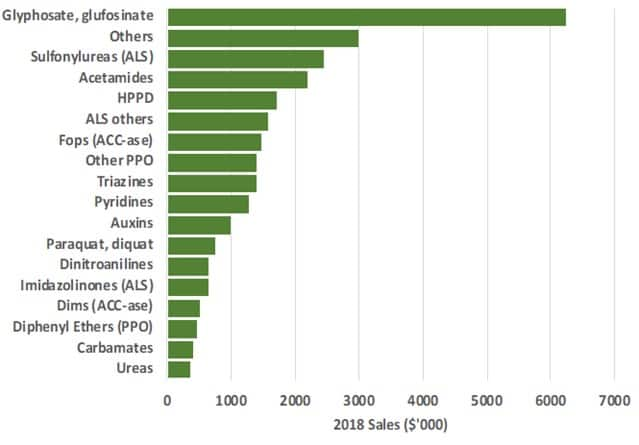Customer Logins
Obtain the data you need to make the most informed decisions by accessing our extensive portfolio of information, analytics, and expertise. Sign in to the product or service center of your choice.
Customer Logins
BLOG
Apr 08, 2020
Blog: Adjuvants and additives in the era of sustainable spraying applications
Adjuvants and additives are routinely used by farmers and growers worldwide, used to enhance the features and benefits associated with the basic formulation of active ingredients, raising them to premium levels of efficacy in crop protection operations. Traditionally they are added with herbicides, however recently a move to using them in combination with insecticides and fungicides has become popular too.
Adjuvants are specifically designed to improve the efficiency of crop protection operations. Tank-mix adjuvants give the manufacturer of these products, as well as farmers and growers, the flexibility to optimise the cost-efficiency of spraying. Developments in both formulation processes and the growth of biologicals have led to the development of many more sophisticated products as having 'built-in' adjuvant systems.
The target of adjuvants and additives varies greatly, however their main purpose is to improve the efficiency of crop protection products. In 2018, the value of the global agrochemical market was $ 65.1 bn. It is expected that this market will grow significantly over the coming years despite the current challenges with regards to the variety of ingredients, product optimization and sustainable use. This gives the market for additives and adjuvants a high growth potential.
As the availability of active ingredients diminishes, the research and development industry are searching for new ways to further optimize adjuvants'. There are several examples showing that major crop protection players are trying to improve their active ingredients, but also extend their products lifecycle and production lines. For example, glyphosate is very responsive to a number of different adjuvants, so as glyphosate continues to grow due to a lack of alternatives, so too does the use of associated adjuvants.
Recent patent applications show that adjuvants are being used to enable a more sustainable use of herbicides, with focus on improving the spraying procedure, reducing the risk of off-target vapour movement or spray drift. There is specific interest in adjuvants' potential to improve the accuracy and efficacy of spray application by drones or UAV's, which could reduce the potential harmful exposure of operators, bystanders, non-target organisms and features of the landscape, especially water bodies.
For fungicides and insecticides, interesting new adjuvants that overcome the challenge of phytotoxicity are being developed. These novel products aim to improve droplet adhesion and increase retention to the leaves of plants. This application would enable a smaller volume of agrochemical to be used alongside a spraying application that isn't reliant on high volumes of water.
With the use of additives and adjuvants offering companies numerous benefits, such as cost savings and environmentally friendly credentials, the market is expected to grow from $2.8 billion in 2016 to $3.6 billion by 2021 at a CAGR of 5.5%. Despite the toxicity issues associated with glyphosate, we expect much of the market growth to be attributed to this active ingredient, partly because of the markets responsiveness and partly because of its huge sales volume.

Figure: Market shares of herbicides in 2018 (Phillips McDougall)
Technology is also expected to play a big role with the use of spraying drones that has already started in Japan, China and S. Korea. New regulations in Europe and N. America are coming that will enable their use, as well as for the products authorized to be used with spraying drones.
As the global crop protection market become more sophisticated, so too will the market for adjuvants and additives, and new complex and differentiated adjuvant/additive targets will secure the markets growth.
Our latest special report Adjuvants and Additives 2020 details a 143 page review of the varying adjuvant technologies for herbicides, fungicides and insecticides as well as reviewing how major crop protection companies are using these.
This article was published by S&P Global Commodity Insights and not by S&P Global Ratings, which is a separately managed division of S&P Global.
{"items" : [
{"name":"share","enabled":true,"desc":"<strong>Share</strong>","mobdesc":"Share","options":[ {"name":"facebook","url":"https://www.facebook.com/sharer.php?u=http%3a%2f%2fqa.www.spglobal.com%2fcommodityinsights%2fen%2fci%2fresearch-analysis%2fblog-adjuvants-additives-sustainable-spraying-applications.html","enabled":true},{"name":"twitter","url":"https://twitter.com/intent/tweet?url=http%3a%2f%2fqa.www.spglobal.com%2fcommodityinsights%2fen%2fci%2fresearch-analysis%2fblog-adjuvants-additives-sustainable-spraying-applications.html&text=Blog%3a+Adjuvants+and+additives+in+the+era+of+sustainable+spraying+applications+%7c+S%26P+Global+","enabled":true},{"name":"linkedin","url":"https://www.linkedin.com/sharing/share-offsite/?url=http%3a%2f%2fqa.www.spglobal.com%2fcommodityinsights%2fen%2fci%2fresearch-analysis%2fblog-adjuvants-additives-sustainable-spraying-applications.html","enabled":true},{"name":"email","url":"?subject=Blog: Adjuvants and additives in the era of sustainable spraying applications | S&P Global &body=http%3a%2f%2fqa.www.spglobal.com%2fcommodityinsights%2fen%2fci%2fresearch-analysis%2fblog-adjuvants-additives-sustainable-spraying-applications.html","enabled":true},{"name":"whatsapp","url":"https://api.whatsapp.com/send?text=Blog%3a+Adjuvants+and+additives+in+the+era+of+sustainable+spraying+applications+%7c+S%26P+Global+ http%3a%2f%2fqa.www.spglobal.com%2fcommodityinsights%2fen%2fci%2fresearch-analysis%2fblog-adjuvants-additives-sustainable-spraying-applications.html","enabled":true}]}, {"name":"rtt","enabled":true,"mobdesc":"Top"}
]}
